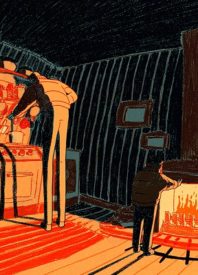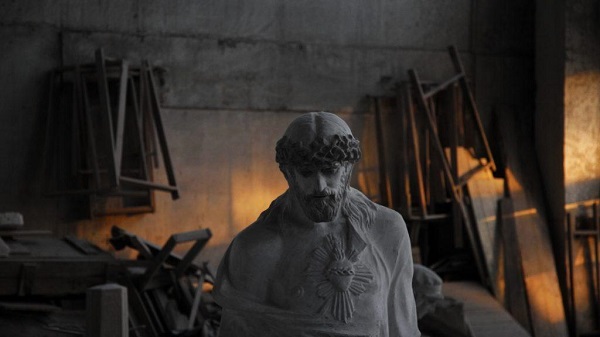
Ice and fire and everything in between. It’s not just exclusive to a certain book. Viewers can also find all of that in the fourth short cuts programme at this year’s TIFF. The theme for this programme is unexpected directions. I don’t necessarily agree that that’s the theme here but it’s what’s along that way that make them unexpected. Let’s begin.
Ice Merchants from Joao Gonzalez is the first short, an animation short showing the titular father and son’s story in two acts. The first shows their routine and the second shows what happens when climate change disrupts that routine. This short is the perfect example of what I wrote in the opening paragraph that what happens within act structures that turn a short from meh to great. I also have biases for old school animation and Gonzalez can have his human figures seem big or small depending on the context. These words feel scientific in comparison to how I actually feel but I already agree with most people that this short should win the Oscar this year.
The next short film, director-writer is David Findlay’s Lay Me By The Shore. It is one big impressionistic montage of a Canadian white boy’s last summer before going into post-secondary school or the job market. This boy, Noah, does things like have sex with his girlfriend, attend fire pit parties – never – and watch his girlfriend do a rap number. He enjoys all of these moments except that there’s a sadness within him. Canadian white boy summer is a subgenre that usually strikes out when I watch it but this short is miles away from previous examples. That’s because of the levels of emotions that it lets its characters show for its short running time.
Snow in September, from Lkhagvadulam Purev-Ochir, chooses an interesting protagonist in Davka (Sukhbat Munkhbaatar). He’s a Mongolian teenager who starts acting weird around his quasi platonic female friend Anuka (Nomin-Erdene Aruinbyamba). This happens after a chance encounter with an enigmatic woman (Enkhgerel Baasanjav) in his building. Enigmatic is also an apt word to describe Davka’s behaviour afterwards. There’s some good character building here that makes him a fascinatingly insane protagonist. And there’s a cleanliness to the visuals that somehow signal something. That Purev-Ochir understands the pros and cons of such a character.
The households in Sanduela Asanda’s Mirror Mirror are in a limbo state between isolation and connection. This is an example of Facetime cinema where two middle class South African girls (Luhle Macanda and Buhle Ngaba) facetime each other. One of them complain about her inability to have an orgasm. I’m probably a bigger fan of digital cinema that most. Or maybe that I like it when small time filmmakers do it in comparison to the ‘auteur’ who uses it a lot. And the protagonist sees her inabilities and connects it to bigger problems in her life. In doing so, it also lets viewers open up those connections to cultural baggage that Black girls face.
Diaspora, from Toronto’s Tyler McKenzie Evans, and it features someone who is dear to Toronto – Rainbow Sun Francks! Here he plays Daniel, a bumbling hipster husband to Melina (Cara Ricketts), who is starting to notice that their fellow Black neighbours are disappearing. Replacing them are nice white people who don’t know about the Black people who recently lived in the houses they now reside on. This is the good kind of trope-y because the trope it uses is obscure enough, the ‘which gender is better at seeing signs of serial killings’ trope. And it’s never the same during every retelling. The art direction also makes this subtly creepy.
Dmytro Sukholytkyy-Sobchuk’s documentary short, Liturgy of Anti-Tank Obstacles is Churchillian. It reminds me of that thing teachers tell us in Catholic, that God made man in his own image. If that’s the case, God as tired as the men in the Ukraine. Specifically, the ones making Christian sculptures despite of the ongoing invasion from the Russian government. There’s both grit and polish here as the images give space to both the men and their surroundings. There are so many interpretations to juxtapositions of the sculptures of Shrist next to the titular obstacles. Its metaphors are obviously poetic yet effectively inspiring.
Salar Pashtoonyar probably gives is the bravest short film in this programme, if not all of the festival with her documentary Hills and Mountains. It captures Afghanistan’s landscapes, showing the houses and structures that dot the country’s rocky cities. There are ironies to this. It looks like any developing country and there are moments of beauty despite the country falling under Taliban’s second rule. Pashtoonyar also uses the story of a woman narrating her life story spanning borders and decades and regimes. Viewers can only imagine that woman’s horros being commonplace within the surfaces of a country with serene surfaces.
Find out how to watch this programme here.
- Release Date: 9/8/2022



